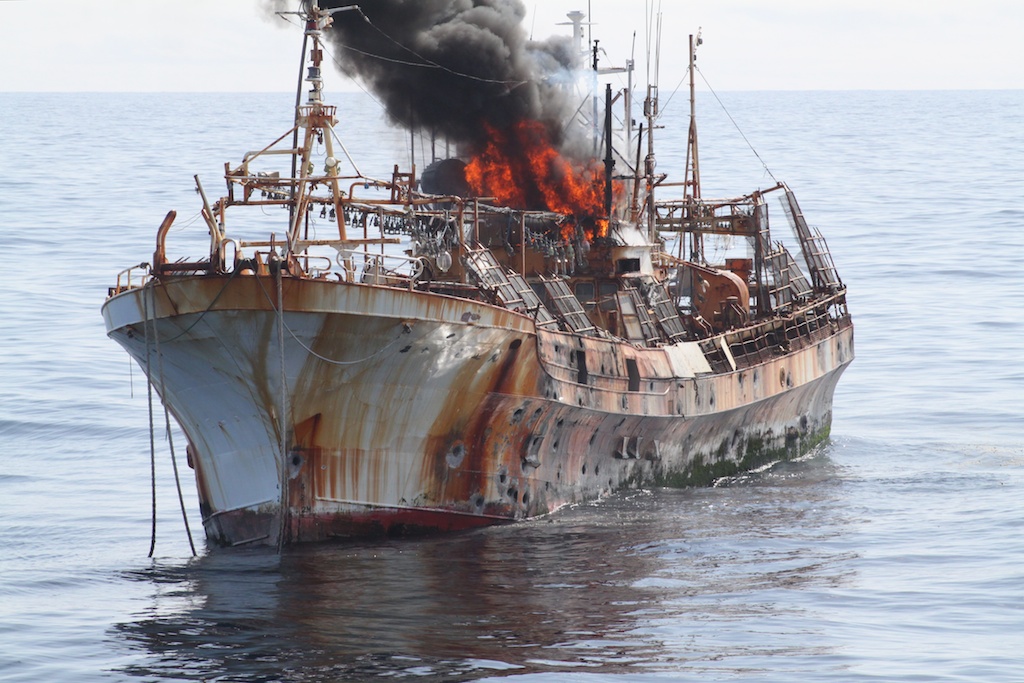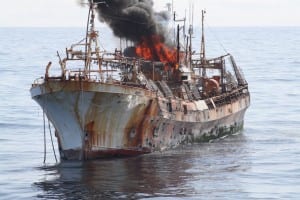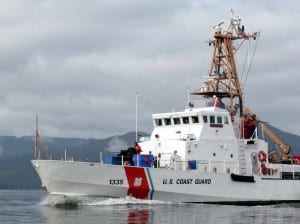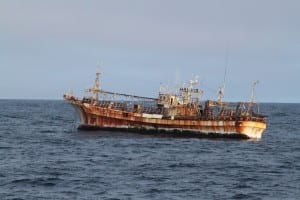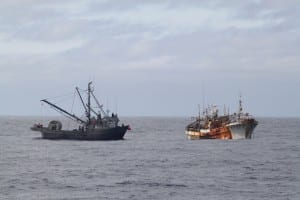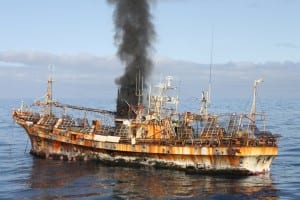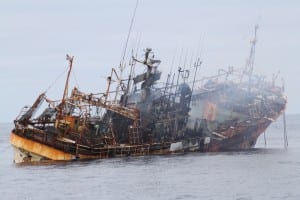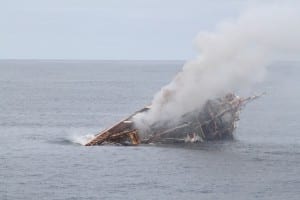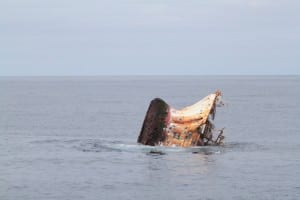The Ghost Ship was not easy to sink. That was the experience for the crew of the Coast Guard cutter Anacapa. They’d practiced with their deck gun but never used it to actually scuttle a ship. The Petersburg-based cutter gained worldwide notoriety last week when she was ordered to sink the derelict, Japanese fishing boat off the coast of Southeast Alaska. The vessel had reportedly been destined for scrap in Japan, but wound up in US waters a year after being set adrift by the Tsunami which devastated that nation. The Coast Guard decided to scuttle the vessel at sea rather than risking a hazard to shipping and potential pollution closer to shore.
Back in Petersburg, several of the Anacapa’s crew gave a first-hand account to Matt Lichtenstein, who filed this report:
Click here to download or play ifriendly audio
The Anacapa is one of three patrol boats based in southeast, but she happened to be the one that was on a higher alert status when US concerns increased over the so-called ghost ship. Commanding officer Reuben Boudreaux says the Coast Guard initially sent his cutter south to Ketchikan to get ready to respond, “It was a good jumping off point. We didn’t know exactly at the time if it was going to drift closer to Dixon entrance which is at the very end of southeast Alaska or if it was going to circle back north and head towards Sitka which it started to eventually head back to that direction.”
After much discussion and preparation, the Coast Guard ordered the Anacapa back north to sink the Ryou Un Maru which was in US waters about 160 miles off shore by this time. Once on the scene, Boudreaux says the crew spent the night making last minute preparations and getting final approval to go ahead and start firing the next morning. That work included checking the derelict vessel for any radiation it may have picked up from the nuclear disasters in Japan. Executive Officer Jim Toomey says the cutter is equipped with an array of detection equipment, “Once we’d arrived on scene and began our study of the vessel, its sea worthiness and any potential hazards that may be on board, we actually used some of that radiation detection equipment doing several passes anywhere from 30 yards to 300 yards off the vessel and conducted basically a spectral analysis of the vessel and we didn’t pick up any elevated levels.”
Some initial reports put the vessel at around 160 feet long, but Toomey says they found it was closer in length to their 110 foot cutter.
The Coast Guard didn’t send any crew aboard the drifting boat, but another vessel did. Shortly before the Anacapa began clearing the area for firing, a Canadian Fishing boat arrived on scene to claim salvage rights. Boudreaux says US and Canadian coast guard officials had a conference call and subsequently agreed to let the would-be salvagers inspect the Japanese ship, “And they were actually able to put personnel on board as we were observing this and determined that it was truly a derelict. Probably not seaworthy enough to tow back all the way to Canada, which was their plan. They reported that the entire vessel was in shambles and could have sunk at any moment.”
But even after being battered by the tsunami and drifting thousands of miles over the last year, the rusty, unmanned fishing boat turned out to be tougher than she looked.
Once the Canadian vessel cleared the scene, the Anacapa prepared to move forward with its task. Boudreaux says first they put out repeated notices to vessels and aircraft, requiring to them to stay at least six nautical miles away from their location. They kept a close eye on radar while a coast guard plane flew over to make sure the area was clear.
They commenced firing about one in the afternoon. Having never done this sort of thing before, Boudreaux says it was a huge learning experience, “Just trying to develop the best plan possible to sink the vessel not knowing how long it would take or how many shots it would take below the waterline. She was a very seaworthy craft obviously coming thousands of miles from west to east across the pacific. She didn’t want to go down easy, that’s for sure.”
They started by firing 220 high explosive rounds from their 25 millimeter deck gun. The cutter had to stay at least 300 yards away from the target vessel for the rounds to fully arm themselves and cause the most damage. At the same, according to Boudreaux, even the relatively calm seas caused enough movement to make it challenging for the Anacapa to hit the other boat below the waterline. “I would like to say that the guys did an incredible job under the circumstances. And obviously we had a few incredible shots that did hit at the waterline or below that did help the process, but there were many other hits on the vessel that didn’t affect the sea worthiness of course until it began to sink into the water a little bit lower.”
After the high explosive rounds didn’t seem to do the trick, Boudreaux says they eventually fired off another 220 rounds of regular non-explosive ammunition. That allowed them to get closer and make shots that were somewhat less destructive but more accurate. Petty Officer 2nd class Brandon Thomas fired 55 of those shots.
“It’s actually incredibly complicated because you have a vessel with a water line that keeps changing because the swells keep moving it up and down and our vessels moving in relation to it. So the mount moves pretty freely and you kind of try and track on there. We have a A-COG site with a little red dot basically on there. So you try and keep that on the waterline and wait for the swells to move and I kind of waited until we were coming downswell and the gun would kind of drop on there otherwise I’d go to hi but it definitely took some trial and error, some practice to hit the vessel where you want,” Thomas says.
Along with the deck gun, they also poured in another 400 rounds of 50 caliber machine gun fire. The Anacapa crew spent several hours waiting to see what impact they had had on the vessel. The Ryou Un Maru eventually sank at 6:15 pm, five hours after firing had started.
Operations Petty Officer Rob Owens was on watch at the time.
Owens says, “It came down from the starboard quarter. That was the first area to go down so the water went over the gunnel at that point. And it just started sinking to stern and starboard quarter and then once that stern caught up to it all throughout it just almost kind of swung underneath the bow and just sank stern first.”
The decision to sink the boat had come from much higher up in the Coast Guard, which saw the unlit, unmanned vessel as a serious danger to navigation in busy shipping lanes. The Anacapa crew saw that first hand. Owens says there were at least three large tankers in the area, one of which couldn’t see the derelict ship on its radar and radioed for its location, “You know it was pretty dangerous for that thing (the derelict vessel) to be out there anyway. You know something like that (the tanker), couldn’t see it on radar and was asking us where it was at.”
Owens and the other crew were confident there was minimal fuel on the vessel, which had been destined for scrap in Japan. The morning following the sinking a coast guard aircraft on scene reported a small amount of debris and a light sheen that the agency said would dissipate quickly at sea. Anacapa commander Boudreaux says he’s proud of his crew and he thinks their experience may help the Coast Guard deal with future situations like this.
“There’s going to be some great lessons learned as a result of this, especially moving forward and thinking that there may be some more vessels along the way that are going to be drifting in our direction. They’re estimating a million or 2 million tons potentially of debvris that’s going to be following that same path and hitting Hawaii, British Columbia and Alaska in the next year or two. So this may not be the last we see of debris that needs to get discharged at sea,” Boudreaux says.
The Ryou Un Maru sank in 6 thousand feet of water.

